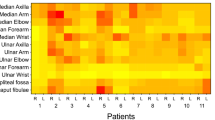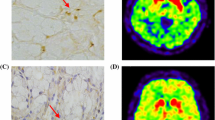Abstract
The diagnosis of Val30Met familial amyloidotic polyneuropathy (FAP) is based on genetic tests, clinical manifestations, familial history and biopsy of peripheral tissues (e.g. rectum, abdominal fat pad, sural nerve, and minor salivary gland) to confirm the presence of amyloid deposits. The aim of this study was to determine the frequency of amyloid deposits in minor salivary glands biopsied from FAP patients and to investigate whether an association exists between the presence of these deposits and clinical features. Seventeen patients with FAP were submitted to minor salivary gland biopsy to confirm the presence of amyloid deposits. The histopathology of the salivary glands confirmed glandular amyloid deposits in nine symptomatic patients (sensitivity of 75.0%). In general, FAP patients who tested positive for glandular amyloid deposits exhibited significantly higher frequencies of sensorimotor and dysautonomic dysfunctions (p = 0.001) compared with those who tested negative. None of the patients reported xerostomia. Minor salivary gland biopsy may help confirm the diagnosis of FAP in symptomatic cases, as it is noninvasive, easy to execute, and causes minimal discomfort to patients.

Similar content being viewed by others
References
Planté-Bordeneuve V, Said G (2011) Familial amyloid polyneuropathy. Lancet Neurol 10:1086–1097
Shin SC, Robinson-Papp J (2012) Amyloid neuropathies. Mt Sinai J Med 79:733–748
Coelho T, Maurer MS, Suhr OB (2013) THAOS—The Transthyretin Amyloidosis Outcomes Survey: initial report on clinical manifestations in patients with hereditary and wild-type transthyretin amyloidosis. Curr Med Res Opin 29:63–76
Saporta MA, Zaros C, Cruz MW et al (2009) Penetrance estimation of TTR familial amyloid polyneuropathy (type I) in Brazilian families. Eur J Neurol 16:337–341
Hemminki K, Li X, Försti A, Sundquist J, Sundquist K (2013) Incidence of hereditary amyloidosis and autoinflammatory diseases in Sweden: endemic and imported diseases. BMC Med Genet 14:88
Kato-Motozaki Y, Ono K, Shima K et al (2008) Epidemiology of familial amyloid polyneuropathy in Japan: identification of a novel endemic focus. J Neurol Sci 270:133–140
Ando Y, Coelho T, Berk JL et al (2013) Guideline of transthyretin-related hereditary amyloidosis for clinicians. Orphanet J Rare Dis 8:31
Hund E (2012) Familial amyloidotic polyneuropathy: current and emerging treatment options for transthyretin-mediated amyloidosis. Appl Clin Genet 5:37–41
Guy CD, Jones CK (2001) Abdominal fat pad aspiration biopsy for tissue confirmation of systemic amyloidosis: specificity, positive predictive value, and diagnostic pitfalls. Diagn Cytopathol 24:181–185
Delgado WA, Mosqueda A (1989) A highly sensitive method for diagnosis of secondary amyloidosis by labial salivary gland biopsy. J Oral Pathol Med 18:310–314
Hachulla E, Janin A, Flipo RM et al (1993) Labial salivary gland biopsy is a reliable test for the diagnosis of primary and secondary amyloidosis. A prospective clinical and immunohistologic study in 59 patients. Arthritis Rheum 36:691–697
Dupond JL, de Wazières B, Saile R et al (1995) Systemic amyloidosis in the elderly: diagnostic value of the test of subcutaneous abdominal fat and the labialsalivary glands. Prospective study in 100 aged patients. Rev Med Intern 16:314–317
Lechapt-Zalcman E, Authier FJ, Creange A, Voisin MC, Gherardi RK (1999) Labial salivary gland biopsy for diagnosis of amyloid polyneuropathy. Muscle Nerv 22:105–107
Dhingra S, Krishnani N, Kumari N, Pandey R (2007) Evaluation of abdominal fat pad aspiration cytology and grading for detection in systemic amyloidosis. Acta Cytol 51:860–864
Do Amaral B, Coelho T, Sousa A, Guimarães A (2009) Usefulness of labial salivary gland biopsy in familial amyloid polyneuropathy Portuguese type. Amyloid 16:232–238
Sacsaquispe SJ, Antúnez-de Mayolo EA, Vicetti R, Delgado WA (2011) Detection of AA-type amyloid protein in labial salivary glands. Med Oral Patol Oral Cir Bucal 16:e149–e152
Mercan R, Bıtık B, Tezcan ME et al (2014) Minimally invasive minor salivary gland biopsy for the diagnosis of amyloidosis in a rheumatology clinic. ISRN Rheumatol 2014:354648
Adams D, Suhr OB, Hund E et al (2016) First European consensus for diagnosis, management, and treatment of transthyretin familial amyloid polyneuropathy. Curr Opin Neurol 29(Suppl 1):S14–S26
Coutinho P, da Martins Silva A, Lopes Lima J, Resende Barbosa A (1980) Forty years of experience with type I amyloid neuropathy. Review of 483 cases. In: Glenner G, Costa P, de Freitas A (eds) Amyloid and amyloidosis. Excerpta Medica, Amsterdam, pp 88–98
Palácios SA, Bittencourt PL, Cançado EL et al (1999) Familial amyloidotic polyneuropathy type 1 in Brazil is associated with the transthyretin Val30Met variant. Amyloid 6:289–291
Bittencourt PL, Couto CA, Clemente C et al (2005) Phenotypic expression of familial amyloid polyneuropathy in Brazil. Eur J Neurol 12:289–293
Kollmer J, Hund E, Hornung B et al (2015) In vivo detection of nerve injury in familial amyloid polyneuropathy by magnetic resonance neurography. Brain 138:549–562
Author information
Authors and Affiliations
Corresponding author
Ethics declarations
Conflict of interest
None declared.
Rights and permissions
About this article
Cite this article
de Paula Eduardo, F., de Mello Bezinelli, L., de Carvalho, D.L.C. et al. Minor salivary gland biopsy for the diagnosis of familial amyloid polyneuropathy. Neurol Sci 38, 311–318 (2017). https://doi.org/10.1007/s10072-016-2760-1
Received:
Accepted:
Published:
Issue Date:
DOI: https://doi.org/10.1007/s10072-016-2760-1




